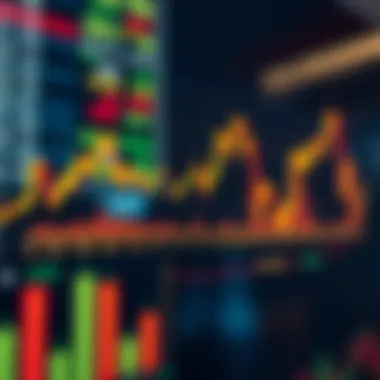The Influence of NFT Companies on Stock Markets


Intro
The world of finance is no stranger to the waves of innovation, but the emergence of non-fungible tokens (NFTs) has sent ripples that few anticipated. NFTs, unique digital assets verified using blockchain technology, are not merely a passing trend; they’ve begun to carve their niche in the broader investment landscape. As these digital tokens gain traction, their influence on stock markets is hard to ignore.
The relationship between NFT companies and stock market dynamics is akin to a dance between two partners, each affecting the other's movements. Investors, financial advisors, and analysts must take heed of how the rise of NFTs is shaping the perceptions and valuations of companies within traditional markets. This article aims to create a road map through this complicated terrain, examining key players, financial metrics, and the trends that signal where the market may head next. To navigate this journey effectively, a solid grasp of essential investment concepts is paramount.
In the discussion to follow, we will break down terms and practices that serve as the foundation for knowledgeable investing in this arena, providing valuable insights that can enhance strategic decision-making.
Investment Terms Explained
To fully appreciate the implications of NFTs on stock markets, it is vital to familiarize oneself with some key investment terms that are often thrown around in financial conversations but may not always be clear. This section will clarify these concepts, ensuring that readers have the essential vocabulary needed to engage thoughtfully with this subject.
Definition of Key Terms
- NFT (Non-Fungible Token): A digital asset that represents ownership of a unique item or piece of content on the blockchain. Unlike cryptocurrencies such as Bitcoin, which are interchangeable, NFTs are one-of-a-kind.
- Market Sentiment: The overall attitude of investors toward a specific asset or the broader market. In the context of NFTs, market sentiment can widely vary, shaped by trends in social media, celebrity involvement, and technological advancement.
- Volatility: The degree of variation of trading prices over time. NFTs are particularly volatile as their worth can shift drastically in response to demand and market events.
- Liquidity: The ease with which an asset can be bought or sold in the market without affecting its price. Unlike traditional stocks, many NFTs can demonstrate low liquidity.
Contextual Use in Investing
Understanding how these terms fit into the investment landscape is crucial. For example, consider market sentiment. An NFT company might witness a surge in its stock price if market sentiment surrounding its product is positive, perhaps due to a viral marketing campaign or high-profile endorsements. Conversely, if sentiment shifts and the tide turns against the market, it could lead to a rapid devaluation.
Investors should also take volatility into consideration when making decisions involving NFT stocks. High volatility may present risks, but it can also create opportunities for those willing to dive into these unpredictable waters. After all, a gambler on roulette might thrive when the stakes are high; however, one must be mindful of the potential for loss too.
"In the world of investing, knowledge is not just power; it's the lifeblood of success."
Expert Financial Advice
As we wade deeper into this territory, experience dictates that some tailored investment strategies are essential for successfully navigating the nexus of NFTs and stock markets. The following strategies could be useful for savvy investors aiming to capitalize on this convergence.
Tailored Investment Strategies
- Diversification: Just as one wouldn’t put all their eggs in one basket, spreading investments across various NFT companies can mitigate risk. This approach aligns with traditional investment strategies, reducing the impact of volatility.
- Research: Before investing, thorough market research is non-negotiable. Understanding which NFT companies are restructuring, entering partnerships, or engaging in innovative projects can give investors a leg up.
- Long-term Perspective: Given the inherent volatility in NFTs, adopting a long-term investment outlook can shield investors from the day-to-day oscillations of market prices.
Risk Management Techniques
- Setting Stop-Loss Orders: By using stop-loss orders, investors can limit potential losses by specifying a price point at which they will sell their shares if a stock falls below a certain level. This practice can be particularly relevant in the unpredictable NFT market.
- Continuous Monitoring: Keeping an eye on market trends and adjusting strategies in real-time ensures investors remain agile and informed. Notifications from reliable financial news sources can also provide insights into market sentiment that may influence stocks.
Ultimately, understanding these terms and strategies lays the groundwork for a more nuanced approach to investing in NFT companies and their stock market impact. Investors who grasp these concepts can position themselves as informed participants in this evolving landscape.
Understanding NFTs and Their Market Presence
Understanding non-fungible tokens (NFTs) is crucial in grasping their influence on the stock market and investment strategies today. NFTs offer a unique digital asset that fundamentally alters ownership concepts, engendering a new marketplace where art, music, and even virtual real estate are bought and sold just like traditional commodities. This section will delve into what NFTs are, how they came about, and the current trends that shape their market presence.
Definition of NFTs
At their core, non-fungible tokens or NFTs are digital certificates created using blockchain technology. Each token is distinct, containing unique information that makes it irreplaceable. This is contrast to cryptocurrencies such as Bitcoin, which are fungible and can be exchanged on a one-to-one basis without loss of value. NFTs can represent anything from digital artworks to collectibles and even virtual avatars. Their value is driven by ownership, rarity, and the demand generated within the market. To put it in simple terms, owning an NFT is like having a one-of-a-kind piece in a gallery, even if a digital copy exists.
Historical Context of NFTs
The journey of NFTs began in 2012 with the introduction of colored coins on the Bitcoin blockchain. However, the concept took off in 2017 with the launch of the Ethereum-based platform, Cryptokitties, which allowed users to buy, breed, and trade virtual cats. This phenomenon captured public attention and opened the floodgates for NFTs as a viable asset class. 2021 marked a watershed moment, as some NFTs fetched millions, propelling them into mainstream consciousness and making market players sit up and take notice of their potential impact on the broader financial landscape.
Current Market Trends
Currently, the NFT market is buzzing with activity and change. Creating, buying, and trading NFTs are not confined to specific niches anymore; they're expanding into sectors like gaming, fashion, and even real estate. Brands like Adidas and Nike are exploring collaborations, while digital artists are thriving by tokenizing their works. The emergence of large platforms like OpenSea and Rarible has simplified the trading of NFTs, making them easily accessible to investors and collectors alike.
"The NFT market has rapidly evolved, showcasing unprecedented diversity in applications and asset types."
Additionally, regulatory discussions are emerging around NFTs as governments try to catch up with this fast-paced evolution. Uncertainty about future regulations creates a double-edged sword for investors: while it may bring risks, it could also lead to greater legitimacy in the long run. Investors today ought to pay close attention to these market shifts and trends, as they directly influence the valuation and stability of stocks associated with NFT companies.
Notable NFT Companies and Their Stocks


The emergence of NFTs has transformed the digital landscape, bringing forth a new class of companies that operate at the frontier of technology and finance. Understanding notable NFT companies and their corresponding stocks is critical for several reasons.
First, investors are constantly on the lookout for high-potential opportunities tied to future technology. As NFTs become more mainstream, companies that capitalize on this trend not only innovate but also command substantial market attention. Their performance on the stock market can provide valuable insights into broader economic trends and investor sentiment.
Secondly, it’s important to look at the financial metrics of these companies, as they can reveal how effectively they are navigating this rapidly evolving space. Comparing their stock performance against market conditions will help investors make informed decisions about where to place their bets in the NFT arena. Ultimately, this section aims to shed light on the dynamics at play between notable NFT companies and the stock market, guiding potential investors in their decision-making process.
Key Players in the NFT Sector
When discussing key players in the NFT sector, several companies consistently come to mind. For instance, OpenSea, often hailed as the leading NFT marketplace, has made a significant splash in the digital collectibles space. Its platform allows users to create, buy, and sell NFTs effortlessly, making it a crucial component of the NFT ecosystem. Another noteworthy player is Rarible, which not only serves as a marketplace but also decentralizes the process by allowing users to create their own NFTs without a hitch.
Additionally, companies like Dapper Labs, creators of the popular NBA Top Shot, have played an essential role in bringing NFTs to the forefront, particularly in the sports memorabilia context. Not to be overlooked, Yuga Labs, the force behind the Bored Ape Yacht Club, has turned heads with its innovative community-driven approach, showing how NFTs can influence social engagement and brand loyalty.
These companies are just the tip of the iceberg, as the NFT sector is predominantly filled with innovators seeking to refine their offerings in ways that resonate with collectors and investors alike.
Stock Performance of Major NFT Firms
Investors keen on understanding the stock landscape surrounding NFT companies should pay close attention to their stock performance metrics. Coinbase, while primarily a cryptocurrency exchange, has ventured into the NFT realm too, and examining its stock responses can give insight into how digital assets are affecting traditional market indices. Observing both ups and downs in stock prices can help analysts surmise how much enthusiasm or skepticism exists around NFTs.
In recent months, it has been noted that some NFT-related stocks have experienced volatility that often mirrors trends seen within the cryptocurrency markets. For instance, a company like Snap Inc., which ventured into creating Snapchat-based AR collectibles, saw fluctuations in its share prices that corresponded with the public's growing interest in NFTs.
"Tracking the performance of NFT firms on stock markets is essential for anyone wanting to navigate this complex terrain with confidence.“
The fluctuations in stock prices can stem from various factors including market sentiment, technological advancements, and changes in regulation that directly or indirectly affect these companies. As such, understanding the nuances of stock performance in relation to these variables can equip investors with a sharper analysis of potential risks and rewards.
Emerging Startups and Their Market Potential
As the NFT industry continues its rapid expansion, numerous emerging startups are trailblazing their way into the forefront. Companies like Nifty Gateway have established themselves as a significant player through collaborations with well-known artists and creators, enabling them to tap into an audience willing to invest in digital art. Their innovative marketplace approach has led to a substantial increase in user engagement, which is a promising sign for potential investors.
Another startup to watch is Mintable, which boasts a user-friendly platform for creating and trading NFTs. As more users become aware of the potential for owning and trading digital assets, Mintable’s growth trajectory could be quite impressive.
Furthermore, The Sandbox, which merges gaming with NFTs, allows players to build and monetize their experiences, demonstrating how the convergence of various digital experiences can create new investment avenues. Its unique model hints at a broader trend in entertainment and commerce that merges personal engagement with investment potential.
Overall, these emerging startups are not just participating in the NFT boom; they’re shaping its future. Their innovative concepts and ability to harness user interest could make them key players to watch as the market continues to develop.
Valuation Metrics for NFT Companies
Understanding the valuation metrics for NFT companies is crucial for investors and analysts alike. As the NFT market grows, measuring the financial health of these companies becomes increasingly important. Multiple metrics can shed light on various aspects, aiding potential investors in making informed decisions.
Revenue Streams in the NFT Market
NFT companies have a handful of revenue streams, each with its unique character and impact. One primary source of income is the sale of NFTs themselves, including digital art, collectibles, and virtual real estate. For instance, platforms like OpenSea or Rarible generate revenue by charging a percentage on transactions. Additionally, many NFT creators earn royalties on secondary sales, which provides a continuous income stream as their artworks or collectibles change hands.
Other revenue sources include partnerships and collaborations with brands seeking to enter the NFT space, merchandise sales, and even subscription models for exclusive content. It's also worth noting that while some companies offer free NFT minting services to attract users, they often have a monetization strategy anchored in transaction fees or premium features that could further increase their earnings potential.
Market Cap Analysis
Market capitalization plays a significant role in evaluating NFT companies, much like traditional firms. It involves calculating the total market value of a company's outstanding shares. However, due to the nascent stage of the NFT industry, market cap numbers can be volatile. Some companies, reflecting rapid growth and high investor interest, may show inflated valuations.
Investors often compare market cap with other metrics, such as revenue or user growth, to assess how fairly valued a company is in relation to its peers. Companies with rapidly increasing user bases or innovative product offerings might trade at higher multiples, reflecting investor optimism about future potential.
"The valuation game isn't merely about numbers but tells a story about a company's vision, its products, and its adaptability in a fluctuating market."
Projected Growth Rates
Projected growth rates serve as a critical indicator of potential success in the NFT industry. Analysts often look at factors such as industry trends, technological advancements, and consumer behavior to make forecasts. The growth trajectory of NFT companies can vary widely based on their niche, market presence, and competitive landscape.
For example, estimates indicate that as more mainstream brands enter the NFT realm, the overall market could explode in the coming years. According to reports, the NFT market could witness a compounding annual growth rate (CAGR) that surpasses 20% over the next few years. Companies that innovate in their offerings or successfully capture market trends will likely lead the charge.
In summary, grasping the valuation metrics for NFT companies equips investors with the tools to navigate this complex landscape. By critically assessing revenue streams, market caps, and growth projections, one can form a comprehensive understanding of where these companies stand and where they could be headed.
Investor Sentiment Surrounding NFT Companies


The topic of investor sentiment surrounding NFT companies holds considerable weight in the broader analysis of how these enterprises influence stock markets. This sentiment can greatly affect market dynamics, investment opportunities, and the overarching perception of NFTs in the business landscape. Gauging how investors feel can reveal trends, predict movements in stock prices, and illuminate potential areas for growth or caution.
Public Perception of NFTs
The public view of NFTs has oscillated dramatically since their inception. Initially seen as a niche market for digital art collectors, NFTs have surged into a broader phenomenon. Many investors look at NFTs through the lens of hype; when people hear about exorbitant bids at auctions or see celebrities diving headfirst into this space, it stirs both excitement and skepticism. The divide is palpable – some embrace NFTs as revolutionary, while others view them as speculative bubbles. This mixed bag influences investor confidence deeply, swaying stock values for companies involved in NFTs.
A significant factor in adopting NFTs hinges on understanding their utility. While some argue that digital ownership is the future, others caution against treating them as mere fads. The clarity of purpose behind NFTs—whether for art, gaming, or utility—shapes their perception and ultimately the willingness of investors to buy in.
Influence of Social Media on Investment Decisions
In today's digital landscape, social media serves as an indispensable tool for shaping investor attitudes. Platforms like Reddit and Twitter can turn minor NFT projects into sensation overnight or correspondingly tarnish reputations with a single tweet. Investors, especially younger ones, often look to influencers and forums for insight, validation, and a sense of community.
Information spread through social media can create hype, but it can also lead to a tidal wave of misinformation. For instance, a viral post touting an NFT can draw investors in droves, while negative sentiments can trigger mass sell-offs. This kind of social media influence makes it imperative for investors to perform their due diligence, discerning between genuine opportunities and hype-driven investments. The social fabric of today’s investment landscape cannot be ignored, especially as NFT companies navigate fluctuating stocks based on narrative and emotion instead of traditional financial metrics.
Market Risks Identified by Investors
As with any evolving market, investment in NFT companies comes with its own set of risks. One major concern is the volatility of NFT values. Digital assets are not bound by the same market principles as traditional stocks and bonds. As a result, investors are often confronted with the uncertainty of whether an asset’s value will rise or plummet due to seemingly arbitrary factors.
Additionally, investors have raised alarms regarding the lack of regulatory clarity in the NFT space. Many are wary of jumping in too early, concerned that sudden shifts in regulations might render existing NFTs obsolete or restrict trading options. Market manipulation is another specter that looms large; without stringent regulations, unscrupulous actors may artificially inflate prices, leaving savvy investors in a lurch.
Cash flows in the NFT market don’t always tell a complete story. Companies heavily invested in NFTs may find themselves swayed by short-term trends rather than sustainable growth. Thus, investors must stay vigilant, regularly assessing the stability of NFT-related companies.
The investor sentiment towards NFT companies can unveil insights into market dynamics and future trends, yet it requires a discerning eye to navigate the waves of hype and risk.
Regulatory Considerations in the NFT Space
Understanding the regulatory landscape surrounding NFTs is crucial for investors, analysts, and entrepreneurs alike. These digital assets, while bursting with potential, often dance precariously close to legal gray areas. The absence of clear regulations can lead to uncertainties that impact both market confidence and the valuation of NFT-related companies. As such, regulatory considerations hold significant weight in shaping the overall market environment for NFTs and their influence on the broader stock market.
Current Regulations Affecting NFTs
As of now, regulatory frameworks for NFTs can vary widely depending on the jurisdiction. However, there are a few key regulations to keep an eye on:
- Securities Laws: In some cases, NFTs could qualify as securities based on their characteristics and uses. This means that they might be subject to stringent regulations under the Securities Exchange Commission (SEC) in the United States. For instance, if an NFT represents an ownership stake in a company or entitles the holder to profits, it may fall under this category.
- Anti-Money Laundering (AML) and Know Your Customer (KYC): Certain NFT marketplaces are beginning to impose KYC and AML protocols. They are trying to ensure that transactions aren't used for illegal activities, thus fostering a safer trading environment, albeit at the cost of user privacy.
- Intellectual Property Rights: Given the tumultuous nature of ownership and copyright in the digital realm, many NFTs flirt with IP laws, leading to potential disputes over content ownership. Regulators are becoming more vigilant about defining how these rights are protected within NFT transactions.
"The regulatory landscape is not just a barrier, it could be a bridge to institutional confidence."
Future Implications of Regulation Changes
The potential for evolving regulations surrounding NFTs opens the door to both opportunities and challenges. Should new regulations take firm shape, these shifts could fundamentally alter the landscape. Here’s how:
- Increased Market Stability: Clear regulatory frameworks can stabilize the market. Investors might feel more secure as rules develop to address past pitfalls like fraud, scams, or copyright infringement. A stable market encourages larger institutional investments.
- Innovation Encouraged: Regulations don't stifle creativity; instead, they might encourage it. For example, clarity on what constitutes a security could pave the way for new NFT projects that cater to compliant frameworks, providing fresh avenues for growth.
- Compliance Costs: On the flip side, increased oversight might lead to greater costs for companies. Startups in the NFT sector may face burdensome compliance costs that could impact their viability and innovation potential. Companies will likely need to invest in legal guidance to navigate the regulatory web, which can divert funds from research and development.
- Global Disparity: It’s also important to consider how these regulations will differ from one country to another. A thriving NFT market in one nation might falter due to stricter regulations in another. Thus, companies must keep their ears to the ground—or at least monitor the political climate in regions where they aim to operate.
Understanding the trajectory of NFT regulations will be paramount for all stakeholders. Ensuring compliance while still fostering innovation can create a more sustainable market environment. As we move forward, watching regulatory bodies adapt to the rapidly changing world of digital assets will be essential.
Technological Innovations and Their Impact
Technological innovations are at the heart of transforming how we perceive ownership, digital art, and value exchange in the modern economy. Within the realm of NFTs, the impact of these technologies can't be understated. They not only reshape user engagement but also influence the stock market dynamics tied to companies venturing into the NFT space. The innovations drive efficiency, create new avenues for revenue, and open up potential challenges—each element carrying weight for investors and businesses alike.
Blockchain Technology and NFTs
Blockchain technology serves as the backbone of the NFT ecosystem. This decentralized ledger system operates on a network of computers, providing authenticity, security, and transparency. Each NFT is inscribed with a unique cryptographic signature, which guarantees ownership and provenance. For instance, when a digital artist sells an NFT of their artwork, buyers can securely trace its history back to the original creator. This offers enormous benefits, including:
- Enhanced Trust: The authenticity of NFTs eliminates worries over forgery. Buyers can have confidence that what they own is genuine.
- Immutable Records: Changes made on the blockchain are permanent, creating a verifiable historical record of ownership.
- Decentralization: By removing intermediaries, blockchain allows for peer-to-peer transactions, potentially lowering costs.
However, investors should also be aware of the challenges that come with integrating blockchain into mainstream businesses and stocks. Market saturation and the need for regulatory compliance can lead to volatility, affecting investor sentiment.
Marketplaces and Their Functionality
NFT marketplaces are the storefronts of the digital asset world. Platforms like OpenSea and Rarible have made it easier for creators and collectors to buy, sell, and trade NFTs. These marketplaces function not just as points of sale but also as hubs for community interaction, showcasing the works of emerging artists alongside established franchises. Key functionalities include:


- User-Friendly Interfaces: Most marketplaces provide an easy-to-navigate interface, suitable for both novice users and experienced investors.
- Diverse Listings: They host a variety of NFTs, from art to music, gaming items, and collectibles, catering to different interests.
- Auction Systems: Many platforms utilize auction-style sales, enabling price discovery based on market demand.
Despite their advantages, potential buyers need to be cautious. Issues such as transaction fees, market manipulation, and a lack of liquidity can complicate the buying process and may impact stock valuations for companies associated with these platforms.
Cross-chain Compatibility Issues
Cross-chain compatibility refers to the ability of different blockchain networks to interact and share information. In the context of NFTs, this is a significant hurdle. Currently, most NFTs are tied to specific blockchains like Ethereum or Solana, which limits their transferability and functionality across other networks. This creates a few points of concern:
- Fragmentation: Each blockchain has its own set of rules and technologies, which can lead to a fragmented market where users may struggle to manage their assets.
- User Frustration: If a user wants to sell or trade an NFT on a different blockchain, they may encounter barriers that complicate transactions.
- Decreased Adoption: For mass adoption of NFTs to occur, seamless interaction across multiple chains is crucial. If not addressed, it may stunt the growth of related NFT businesses, thereby affecting their stock market performance.
The ability to address these cross-chain issues could pave the way for significant advancements in the NFT market. This technological leap would not only benefit individual investors but also enhance the market’s appeal, potentially attracting more institutional investments in NFT companies.
"As the NFT industry matures, the way we harness technological advancements will define its trajectory in both digital and financial landscapes."
Future Trends in NFT Companies and Stocks
The rise of non-fungible tokens (NFTs) has significantly reshaped various segments of the financial landscape. Understanding future trends in NFT companies and their associated stocks is crucial for investors as they navigate an ever-evolving market. This topic highlights specific elements, benefits, and considerations essential for those involved in investment decisions. As the technology and market continua to develop, awareness of potential growth areas, challenges, and strategies for investment becomes paramount.
Predicted Growth Areas
In the coming years, several growth areas are likely to emerge within the NFT landscape:
- Gaming Integration: NFTs in gaming are becoming more prevalent, with companies like Epic Games exploring ownership of in-game assets. As gamers seek to monetize their skills and items, this sector could experience a boom.
- Real Estate Tokenization: The concept of tokenizing real estate assets through NFTs is gaining traction. It allows for fractional ownership, making real estate investment more accessible to a broader audience, while also opening up liquidity options.
- Art and Collectibles: As digital art continues to flourish, the NFT market for art and collectibles will likely expand. Artists are finding new revenue streams through NFT sales, fostering a culture where art can be decentralized and owned directly by collectors.
- Social Media Platforms: With platforms like Twitter and Instagram considering NFT integration, user-generated content could take a new form. This represents a potential maturation of how content is valued and monetized online.
These areas not only represent financial opportunities but also present a shift in how digital ownership and value are perceived.
Potential Challenges Ahead
Even as optimism surrounds the NFT market, significant challenges may hinder growth and stability:
- Market Volatility: NFT values can fluctuate dramatically, creating a risk for investors. Just like the stock market, the NFT space can experience bubbles that, when burst, leave investors facing substantial losses.
- Regulatory Uncertainty: Governments are still figuring out how to regulate NFTs. This uncertainty could affect investor confidence and market operations. For example, potential taxation policies on digital assets could alter the landscape.
- Environmental Concerns: The blockchain technology underpinning NFTs often has a heavy carbon footprint. As sustainability concerns rise, companies may face backlash or pushback from environmentally conscious investors.
- Intellectual Property Issues: The ownership of digital rights can be murky when it comes to NFTs. Questions surrounding copyright and reproduction rights may lead to disputes that could alienate users and investors alike.
Addressing these challenges requires a proactive approach from both companies in the NFT space and investors looking to engage with them.
Investment Strategies for NFTs
To successfully navigate the NFT investment scene, various strategies can be employed:
- Diverse Portfolio Creation: Like any investment, spreading your assets across various NFT sectors can mitigate risk. Consider allocating funds to different areas such as gaming, art, and real estate to cushion against market volatility.
- Research on Token Performance: Make informed decisions by understanding past performance metrics and growth potential of specific NFTs and companies. Resources such as platforms like CoinMarketCap or OpenSea provide valuable data.
- Stay Updated on Regulatory Changes: Regularly check for updates from regulatory bodies to adapt your strategy timely. Websites such as govtrack.us can provide insight into legislation affecting digital assets.
- Join NFT Communities: Engaging in forums such as Reddit can provide not just insights on trends, but also shared experiences that can inform better investment choices.
As the market evolves, these investment strategies will help investors capitalize on opportunities while managing inherent risks. An informed approach will likely yield the best results, allowing for a nuanced engagement with the NFT landscape.
Embracing the future of NFTs means keeping an eye on both the possibilities for growth and the challenges that lie ahead.
Finale and Final Thoughts
The exploration of NFT companies and their correlation with stock markets unveils a complex narrative, rich with potential for both investors and industry observers. As we have seen throughout this article, NFTs have emerged not just as digital assets but also as pivotal players in the financial world. Investors need to grasp the ins and outs of this budding market—it's not merely a passing trend; it’s becoming an entrenched component of the digital economy.
Understanding the interrelationship between NFT companies and stock performance is essential for multiple reasons. Firstly, it helps investors identify viable opportunities in a marketplace that is evolving at a breakneck pace. The ability of NFT firms to adapt and innovate significantly impacts their stock valuations. Secondly, by evaluating financial metrics and market sentiment, it becomes clear that NFT companies are influencing broader economic trends. This can serve as a barometer for overall investor confidence.
Moreover, the regulatory environment surrounding NFTs remains fluid, and its implications could impact future investments. Stakeholders must stay attuned to how regulations may dictate the growth trajectories of these companies. Proactive investors will continually recalibrate their strategies, ensuring they can navigate any turbulent waters that may arise.
In summary, this article sheds light on the critical dynamics at play in the NFT and stock market intersection. When investors equip themselves with detailed knowledge, they position themselves favorably, adapting not just to current trends but also to future possibilities.
Recap of Insightful Findings
- NFT Market Growth: The NFT sector has shown remarkable growth, with numerous companies augmenting their public presence through stock offerings.
- Investment Risks: While the potential rewards can be enticing, associated risks vary, necessitating careful analysis and strategy.
- Emerging Trends: The continual evolution of technology and shifting regulations point toward a vibrant future filled with both challenges and opportunities.
"Investors must be as quick as a fox but steady as an old tortoise in the ever-changing landscape of NFTs."
Navigating the Investment Landscape
In navigating the intricate environment of NFT investments, several strategies should be acknowledged:
- Research is Key: Investors should spend adequate time analyzing companies' fundamentals and their market positioning relative to competitors.
- Stay Updated: Regularly following news outlets and platforms dedicated to the blockchain and NFT sectors can provide valuable insights, helping investors stay ahead of the curve.
- Diversification: Much like any other investment strategy, not putting all eggs in one basket remains prudent. Explore a range of NFT companies as well as traditional assets to cushion against market volatility.
Crucially, being part of investor communities on platforms like Reddit or Facebook can foster the exchange of insights and real-time information, which is invaluable in a rapidly shifting market. By equipping oneself with knowledge, investors can not only make informed decisions but also contribute to a more well-rounded perspective on the potentials of NFT investments and their impact on stock markets.















